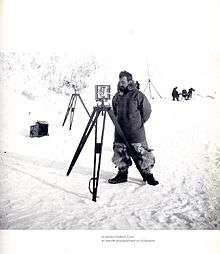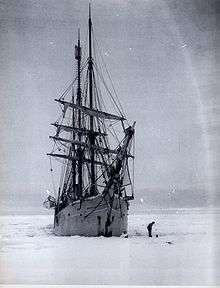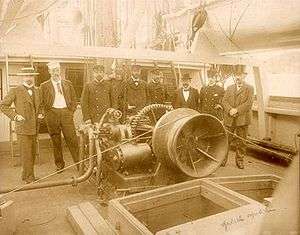Belgian Antarctic Expedition

The Belgian Antarctic Expedition (BelgAE) of 1897 to 1899 was the first expedition to winter in the Antarctic region.
Preparation and surveying
In 1896, after a period of intensive lobbying, Adrien de Gerlache purchased the Norwegian-built whaling ship Patria, which, following an extensive refit, he renamed as the RV Belgica.[1] Belgian de Gerlache had worked together with the Geographical Society of Brussels to organize a national subscription, but was only possible to outfit his expedition after the Belgian government voted in favor of two large subsidies, making it a state-supported undertaking.[2] With a multinational crew, which included Roald Amundsen, Emil Racoviță and Henryk Arctowski, they set sail from Antwerp on 16 August 1897.
After leaving Antwerp, the expedition visited Madeira, Rio de Janeiro and Montevideo. The Belgica was especially received enthusiastically in Rio, where a large Belgian community lived. Frederick Cook joined the expedition here. The Brazilians were also very interested in the Belgian scientific undertaking. The Historical and Geographical Society of Rio held a special meeting where the scientists and officers of the expedition were offered membership.[3][4] A few weeks later, in Montevideo, Amundsen wrote in his diary that he had never seen so many beautiful women 'in one place at the same time'.[5]
During January 1898, the Belgica reached the coast of Graham Land. On 22 January Carl Wiencke was washed overboard during a storm and drowned.[6] Wiencke Island was named in his honor. Sailing in between the Graham Land coast and a long string of islands to the west, de Gerlache named the passage Belgica Strait. Later, it was renamed Gerlache Strait in his honor. After charting and naming several islands during some 20 separate landings, they crossed the Antarctic Circle on 15 February 1898.
Failing to find a way through into the Weddell Sea, on 28 February 1898, de Gerlache's expedition became trapped in the ice of the Bellinghausen Sea, near Peter I Island. It is likely that de Gerlache intentionally sailed deep into the pack ice in order to freeze his vessel into the ice for the winter.[7] Despite efforts of the crew to free the ship, they quickly realised that they would be forced to spend the winter on Antarctica.
Winter


They were poorly equipped and did not have enough winter clothing for every man on board. There was a shortage of food, and what there was lacked in variety. Penguins and seals were killed and the meat stored before the onset of winter. Warm clothing was improvised out of the materials available.
On 21 March 1898 the expedition's doctor Frederick Cook wrote:
We are imprisoned in an endless sea of ice... We have told all the tales, real and imaginative, to which we are equal. Time weighs heavily upon us as the darkness slowly advances.
Several weeks later, on 17 May, total darkness set in, which lasted until 23 July.
Adrien de Gerlache disliked the fresh penguin and seal meat that had been killed and stored before the onset of winter and initially tried to ban their consumption, but eventually encouraged it.[8] Signs of scurvy began to show in a number of the men. Lecointe and de Gerlache became so ill they wrote their wills, two of the crew started to show signs of mental illness and morale in general was extremely poor. Lt. Danco fell ill from a heart condition and died on 5 June 1898.[6] Danco Island was named after him. Several men lost their sanity, including one Belgian sailor who left the ship "announcing he was going back to Belgium".
Frederick Cook and the First Mate, Roald Amundsen, then took command as de Gerlache and Lecointe were unable to fulfil this role due to scurvy. Vitamin C was not discovered until the 1920s but Cook was convinced that fresh meat was the cure for scurvy due to his experiences with Robert Peary in the Arctic. He retrieved the frozen penguin and seal meat and insisted that each man ate some each day. Even de Gerlache began to eat the meat and slowly the men all recovered their health.[4]
Several months of hardship followed. Attempts to free the ship and its crew from the clutches of the ice failed. By January 1899 the Belgica was still trapped in ice about 7 feet (2.1 m) thick and the possibility of another winter in the ice was becoming real. Open water was about half a mile away and Cook suggested that trenches should be cut to the open water to allow the Belgica to escape the ice. The weakened crew used dynamite and various tools to create the channel. Finally, on 15 February 1899, they managed to slowly start down the channel they had cleared during the weeks before. It took them nearly a month to cover 7 miles, and on 14 March they cleared the ice. The expedition returned to Antwerp on 5 November 1899. The conditions were hard but nevertheless the expedition still managed to collect a significant amount of scientific data including a full year of meteorological observations.
Reception
In Antwerp, the expedition was heartily welcomed. A special committee had been planning the festivities for months.[9] Typical for polar expeditions in this age, feelings of national (and regional) pride surrounded the homecoming celebrations. On the day they first set foot on Belgian soil again, the Brabançonne sounded and the national flag was seen waving from many houses. The Belgian state honored de Gerlache and his men by making them members of the Royal Order of Leopold, and the municipal government of Antwerp honored the men by medals and writing their names in the Golden Book of the city.
Personnel

The expedition team included some notable individuals:
- Adrien de Gerlache (1866–1934): Belgian – leader
- Georges Lecointe (1869–1929): Belgian – Captain, executive officer and hydrographer (second in command on the Belgica)
- Roald Amundsen (1872–1928): Norwegian – First Mate. Amundsen learned much from his experience on this expedition, in particular how to prevent scurvy.
- Frederick Cook (1865–1940): American – Surgeon, anthropologist and photographer.
- Henryk Arctowski (1871–1958): Pole – geologist, oceanographer and meteorologist
- Emile Danco (27 November 1869 – 5 June 1898): Belgian – geophysical observations. Emile Danco was born in Mechelen and received a very rigid upbringing from his father, a lieutenant-colonel in the Belgian army. His mother died while he was still an infant. He entered the Royal Military Academy in 1888 and after completing his studies obtained a commission as an artillery lieutenant in 1891. That year, his father died and Danco wanted to travel abroad. He tried to be detached to the French Navy, like his friend Lecointe, but the Belgian government declined his request. Next, he applied to de Gerlache, also a personal friend, for a position in the Belgian Antarctic Expedition, and even made a substantial donation to the expedition fund. Initially, de Gerlache was hesitant to accept his offer since he knew that Danco had cardiac problems, but gave in at the end. The Belgian army was not so forthcoming: it took an intervention from the archbishop of Mechelen to obtain permission to participate. He prepared by studying magnetism and meteorology and learned to ski in Norway, where he assisted de Gerlache with the preparation of the Belgica. During the expedition he performed regular magnetic observations and assisted Arctowski, until May 1898, when he felll ill. He remained bedridden, but optimistic, until his death. The wake and burial at sea weighted heavily on the other expedition members. Lecointe took over his observations and published a biography in the resulting scientific report.[10] Danco Coast (originally Danco Land), Danco Island and the asteroid 9812 Danco were named in his honor.
- Emil Racoviță (1868–1947): Romanian – biologist (zoologist and botanist) and speleologist
- Antoni Bolesław Dobrowolski (1872–1954): Polish – assistant-meteorologist
.jpg)
- Jules Melaerts (1876–?): Belgian – third lieutenant. In 1908 he was second-in-command on the training ship Comte de Smet de Nayer and later became harbourmaster in Zeebrugge.[11]
- Henri Somers (1863–?): Belgian – chief mechanic. After his return he became chief mechanic of the Ostend-Dover ferries.[11]
- Max Van Rysselberghe (1878–?): Belgian – mechanic. From a famous family of artists and academics, including Théo van Rysselberghe. After his return to Belgium, he married the daughter of an exiled Chilean minister and ultimately settled in Chile in 1905, where he had a successful career in engineering. His descendants are involved in politics.[5][12]
- Louis Michotte (1868–1926): Belgian – steward, later cook. Michotte volunteered to take over as a cook after the original cook was fired and his replacement became ill. His cooking was not universally acclaimed, as Frederic Cook wrote:[4]
His soups are full of "mystery," and the "embalmed meats" are on every tongue for condemnation.
This affected the expedition's nutrition negatively, since de Gerlache tried to ban the consumption of fresh seal and penguin meat after sampling Michotte's badly prepared dishes. Frederic Cook convinced the sick expedition members much later to eat it, as a medicine rather than as food.[13] On his return to Belgium he became the butler of Philippe d'Orléans, and in this capacity participated in the 1905 Belgica expedition to Spitsbergen and Greenland, with the Gerlache as captain.[14]
- Adam Tollefsen (1866–?): Norwegian – sailor. Suffered from a mental breakdown during the expedition and had to be committed to a mental institution on his return, where he died shortly afterwards.[11]
- Ludvig-Hjalmar Johansen (1872–?): Norwegian – sailor.
- Engelbret Knudsen (1876–March 1900): Norwegian – sailor. Died shortly after the expedition.
- Gustave-Gaston Dufour (1876–16 March 1940): Belgian – sailor. After his return he moved to Congo where he suffered from a stroke and was paralyzed. He died in 1940 while still in a hospital.[11]
- Jan Van Mirlo (1877–1964): Belgian – sailor. Born in Antwerp, conscripted, but allowed to fulfill his military service on board the Belgica. After his return he obtained a position as lock keeper in recognition of his participation in the expedition. He regularly returned to life at sea as a sailor for a few months at time and was well known in artistic circles in his hometown. The poet Jan van Nijlen published the poem De Gedroomde Reis based on his experiences in the Antarctic. At the end of his life his wife had him committed to a mental institution due to his free-spending habits. His memoirs formed the basis of the historical novel De Winter van de Belgica (Winter of the Belgica).[5][15][16]
- Carl August Wiencke (1877–1898): Norwegian – sailor. Wiencke was washed overboard and drowned on the way to Antarctica.
- Johan Koren (1877–3 March 1919): Norwegian – cabin boy and assistant zoologist. He was a theology student before the expedition and became a preacher after his return. He died in 1919 in Vladivostok.[11]
Koren brought on board Nansen, the ship's cat on the Expedition. He was named after Fridtjof Nansen. He died on 22 June 1898,[17] and was buried in the Antarctic.[18]
In addition there are a number of people who only participated in part of the expedition.[5] These are:
- Johansen (Norwegian, boatswain): Sandefjord - Ostend. Resigned on 22 August 1897
- Julliksen (Norwegian, carpenter): Sandefjord - Ostend. Resigned on 22 August 1897
- Josef Duvivier (Belgian, mechanic): Antwerp - Rio de Janeiro, Montevideo - Punta Arenas. Fired on 26 October 1897 in Rio de Janeiro, hired again on 14 November 1897 in Montevideo, fired again in Punta Arenas due to incompetence.
- Lemonier (French, cook): Antwerp - Montevideo. Fired on 13 November 1897 due to bad behavior
- Jan Van Damme (Belgian, sailor): Antwerp - Punta Arenas, fired on 11 December 1897 due to insubordination
- Maurice Warzee (Belgian, sailor): Antwerp - Punta Arenas, fired on 11 December 1897 due to insubordination
- Frans Dom (Belgian, sailor): Antwerp - Punta Arenas, fired on 11 December 1897 due to insubordination
The original ship's surgeon had resigned in Ostend and was replaced by Cook. Lemonier was replaced in Montevideo by a Swede, who had to resign in Punta Arenas due to illness. His duties were taken over by Michotte.
See also
| Wikimedia Commons has media related to Belgica. |
- Belgian Antarctic Program
- List of Antarctic expeditions
- Heroic Age of Antarctic Exploration
- Bayard Islands
References
- ↑ de Gerlache, Adrien (1902). Quinze Mois dans l'Antarctique (in French). Bruxelles: Ch. Bulens.
- ↑ A. Cabay, 'The funding of the Belgian Antarctic expedition 1897–1899' in: Decleir, H. en C. De Broyer ed., The Belgica expedition centennial: perspectives on Antarctic science and history (Brussels 2001) 83–92.
- ↑ A. de Gerlache de Gomery, Fifteen months in the Antarctic (Bluntisham 1998) 22.
- 1 2 3 Cook, Frederick A. (1900). Through The First Antarctic Night 1898–1899: A Narrative Of The Voyage Of The "Belgica" Among Newly Discovered Lands And Over An Unknown Sea About The South Pole. New York: Doubleday & McClure Co. ISBN 978-0-905838-40-3.
- 1 2 3 4 Amundsen, Roald (1999). Decleir, Hugo, ed. Roald Amundsen's Belgica Diary: The First Scientific Expedition to the Antarctic. Bluntisham Books. ISBN 9781852970581.
- 1 2 Kløver, Geir O., ed. (2010). Antarctic Pioneers. The Voyage of the Belgica 1897-99. Oslo, Norway: The Fram Museum. ISBN 978-82-8235-007-5.
- ↑ "Belgian Antarctic Expedition 1897 – 1899".
- ↑ Anthony, Jason C. (2012). Hoosh: Roast Penguin, Scurvy Day, and Other Stories of Antarctic Cuisine. U of Nebraska Press. p. 47. ISBN 9780803244740.
Moreover, Gerlache had sampled the animals, badly prepared by cook Louis Michotte, and found them so disgusting that he tried to ban them from the Belgica.
- ↑ 'Expedition Antarctique Belge. Reception solonnelle des explorateurs a leurs arrivée a Anvers' in: Bulletin de la Société Royale de Géographie d'Anvers 24 (1900) 5–17.
- ↑ Lecointe, Georges (1907). Physique du globe: mesures pendulaires (PDF). Résultats du Voyage du S.Y. Belgica en 1897-1898-1899 sous le commandement de A. de Gerlache de Gomery: Rapports Scientifiques (1901-1913) (in French). Anvers: Buschmann. pp. 3–7.
- 1 2 3 4 5 Verlinden, Jozef (1993). Poolnacht - Adrien de Gerlache en de Belgica-expeditie (in Dutch). Tielt: Lannoo. ISBN 902092298X.
- ↑ Dettwiler Rodríguez, Gretel (2008-01-17). "Los Van Rysselberghe, belgas dignos de novela de aventuras". El Sur (in Spanish). Concepción. Retrieved 2013-04-24.
- ↑ Anthony, Jason C. (2012). Hoosh: Roast Penguin, Scurvy Day, and Other Stories of Antarctic Cuisine. U of Nebraska Press. ISBN 9780803244740.
- ↑ Kjær, Kjell-G. (July 2005). "Belgica in the Arctic" (PDF). Polar Record. 41 (3): 205–214. doi:10.1017/S0032247405004420.
- ↑ Van den Bossche, Stefan (2005). Jan van Nijlen: biografie (in Dutch). Tielt: Lannoo Uitgeverij. pp. 190–191. ISBN 9789077441015.
- ↑ van der Kaap, Albert. "De winter van de Belgica, Willy Schuyesmans" (in Dutch). Retrieved 2013-04-24.
- ↑ Lewis, Val (2002). Ship's Cats in War and Peace. Shepperton: Nauticalia Ltd. pp. 59–60. ISBN 0-9530458-1-1.
- ↑ "Adrien de Gerlache, Belgica Belgian Antarctic Expedition 1897 - 1899". Cool Antarctica. Archived from the original on 9 October 2010. Retrieved 5 October 2010.
Literature
- Amundsen, Roald, Decleir, H. (ed), Roald Amundsen's Belgica Diary. The first scientific expedition to the Antarctic (Bluntisham 1999)
- Baughman, T.H. Before the heroes came. Antarctica in the 1890s (Nebraska 1994)
- Cook, Frederick A. Through The First Antarctic Night 1898–1899: A Narrative Of The Voyage Of The "Belgica" Among Newly Discovered Lands And Over An Unknown Sea About The South Pole. (New York: Doubleday & McClure Co. 1900) ISBN 978-0-905838-40-3
- Decleir, H., de Broyer, C. (eds), The Belgica expedition centennial: perspectives on Antarctic science and history (Brussels 2001)
- de Gerlache de Gomery, A., M. Raraty (translation), Fifteen months in the Antarctic (Bluntisham 1998)
- anon., Expedition Belge au Pôle Sud: la Belgica et son Equipage (Anvers: Bellemans, s.a. 1897)
Contemporary sources
- Bulletin de la Société Royale de Géographie d'Anvers vol 20–24(1896–1900).
- Bulletin de la Société Royale Belge de Géographie vol 20–24 (1896–1900).